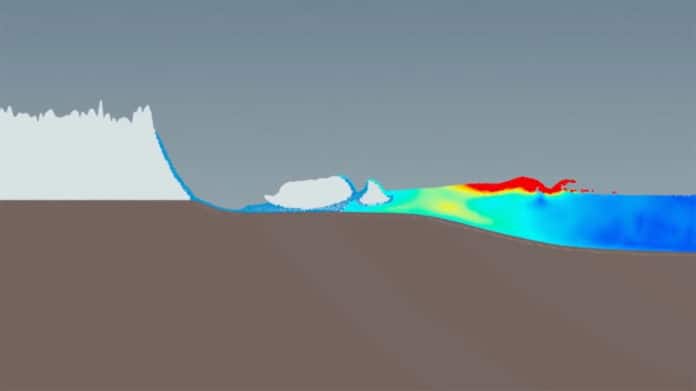Glaciers calving icebergs into the ocean significantly contribute to sea-level rise and can trigger tsunamis, posing severe hazards for coastal regions. Computational modeling of such multiphase processes is a great challenge involving complex solid-fluid interactions.
To better understand the correlation between the size of an iceberg and the tsunami’s amplitude that results from its calving, Johan Gaume from EPFL and his team have developed a new model for simulating both icebergs calving and the tsunamis that are triggered as a result.
The phenomena simulate the phenomena of both dynamic glacier fracture under the combined effects of gravity and buoyancy and the subsequent propagation of tsunami-like waves induced by released icebergs. This new Material Point Method can also provide insight into the specific mechanisms involved in glacial rupture.
Gaume, who heads EPFL’s Snow Avalanche Simulation Laboratory (SLAB), said, “Our goal was to model the explicit interaction between water and ice – but that has a substantial cost in terms of computing time. We, therefore, decided to use a continuum model, which is very powerful numerically and which gives results that are both conclusive and consistent with much of the experimental data.”
“Researchers can use the results of our simulations to refine the calving laws incorporated into their large-scale models for predicting sea-level rises while providing detailed information about the size of icebergs, which represent a sizeable amount of mass loss.”
Calving is when chunks of ice break off at the terminus or end of a glacier. Depending on the shape of the glacier outlet, this may lead to different calving scenarios. Glacier calving can have dramatic consequences, as falling or capsizing icebergs can generate large tsunamis, threatening coastal infrastructure, ecology, and people.
Gaume said, “Another event that can trigger a tsunami is when an iceberg’s center of gravity changes, causing the iceberg itself to rotate. We were able to simulate all these processes.”
In Greenland, the scientists placed a series of sensors at Eqip Sermia, a 3-km-wide outlet glacier of the Greenland ice sheet that ends in a fjord with a 200 m ice cliff. Scientists were able to reproduce the main features of tsunamis obtained in laboratory experiments and calving characteristics.
Gaume said, “Our method will also be used to model chains of complex processes triggered by gravitational mass movements, such as the interaction between a rock avalanche and a mountain lake.”
Journal Reference:
- Wolper, J., Gao, M., Lüthi, M.P. et al. A glacier–ocean interaction model for tsunami genesis due to iceberg calving. Commun Earth Environ 2, 130 (2021). DOI: 10.1038/s43247-021-00179-7
